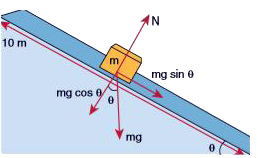Text Solution
Verified by Experts
|
Topper's Solved these Questions
WORK, ENERGY AND POWER
NCERT TAMIL|Exercise EXERCISE - MULTIPLE CHOICE QUESTIONS|15 VideosView PlaylistWORK, ENERGY AND POWER
NCERT TAMIL|Exercise EXERCISE - IV. NUMERICAL PROBLEMS|5 VideosView PlaylistWORK, ENERGY AND POWER
NCERT TAMIL|Exercise EXERCISES (ADDITIONAL EXERCISES)|7 VideosView PlaylistWAVES
NCERT TAMIL|Exercise EVALUATION(IV. NUMERICAL PROBLEMS)|7 VideosView Playlist
Similar Questions
Explore conceptually related problems
Knowledge Check
A
B
C
D
Submit
A
B
C
D
Submit
A
B
C
D
Submit
Similar Questions
Explore conceptually related problems
NCERT TAMIL-WORK, ENERGY AND POWER-EXAMPLE
- A box is pulled with a force of 25 N to produce a displacement of 15 m...
Text Solution
|
Play - An object of mass 2 kg falls from a height of 5 m to the ground. What ...
Text Solution
|
Play - An object of mass m = 1 kg is sliding from top to bottom in the fricti...
Text Solution
|
Playing Now - If an object of mass 2 kg is thrown up from the ground reaches a heigh...
Text Solution
|
Play - If an object of mass 2 kg is thrown up from the ground reaches a heigh...
Text Solution
|
Play - If an object of mass 2 kg is thrown up from the ground reaches a heigh...
Text Solution
|
Play - A weight lifter lifts a mass of 250 kg with a force 5000 N to the heig...
Text Solution
|
Play - A weight lifter lifts a mass of 250 kg with a force 5000 N to the heig...
Text Solution
|
Play - A weight lifter lifts a mass of 250 kg with a force 5000 N to the heig...
Text Solution
|
Play - A variable force F=kx^(2) acts on a particle which is initially at res...
Text Solution
|
Play - Two objects of masses 2 kg and 4 kg are moving with the same momentum ...
Text Solution
|
Play - Two objects of masses 2 kg and 4 kg are moving with the same momentum ...
Text Solution
|
Play - An object of mass 2 kg is taken to a height 5 m from the ground (g = 1...
Text Solution
|
Play - An object of mass 2 kg is taken to a height 5 m from the ground (g = 1...
Text Solution
|
Play - An object of mass 2 kg is taken to a height 5 m from the ground (g = 1...
Text Solution
|
Play - An object of mass 2 kg is taken to a height 5 m from the ground (g = 1...
Text Solution
|
Play - Let the two springs A and B be such that k(A) gt k(B). On which spring...
Text Solution
|
Play - A body of mass m is attached to the spring which is elongated to 25 cm...
Text Solution
|
Play - A body of mass m is attached to the spring which is elongated to 25 cm...
Text Solution
|
Play - A body of mass m is attached to the spring which is elongated to 25 cm...
Text Solution
|
Play
